How To (Easily) Write Product Descriptions That Don’t Suck
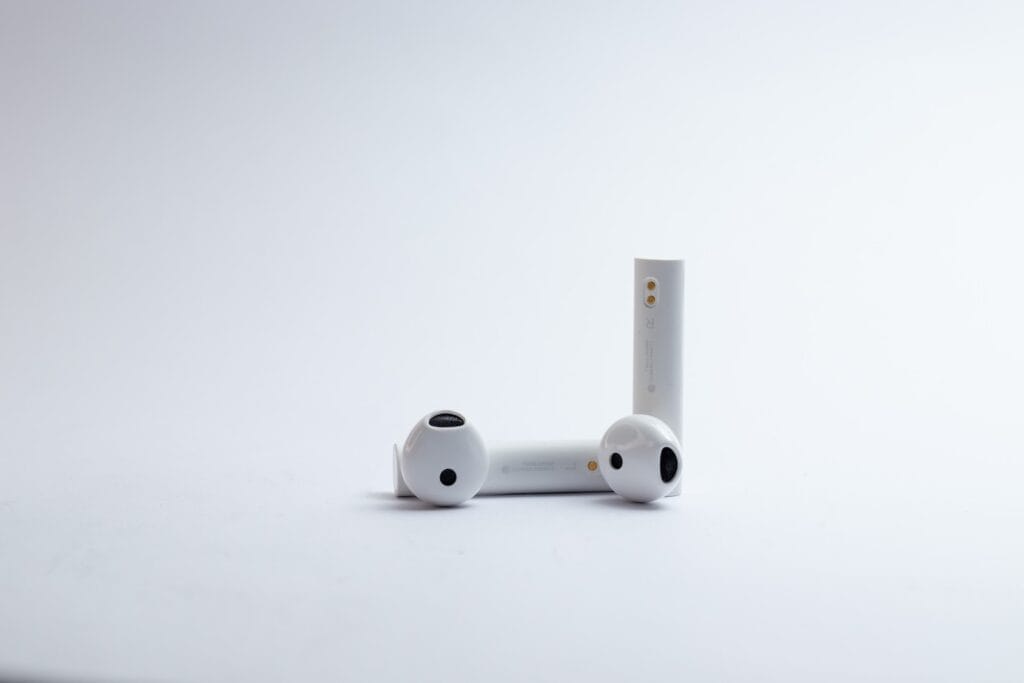

A product description describes what your product does, how it solves your customer’s problem, and overall why the customer should give a hoot about it. That’s all, folks.
Writing copy that connects with your customers and moves them beyond a product’s price and features. This is you reaching into the minds of your customers, taking them on a journey with you, and having them imagine their life with your product in it. Like this:
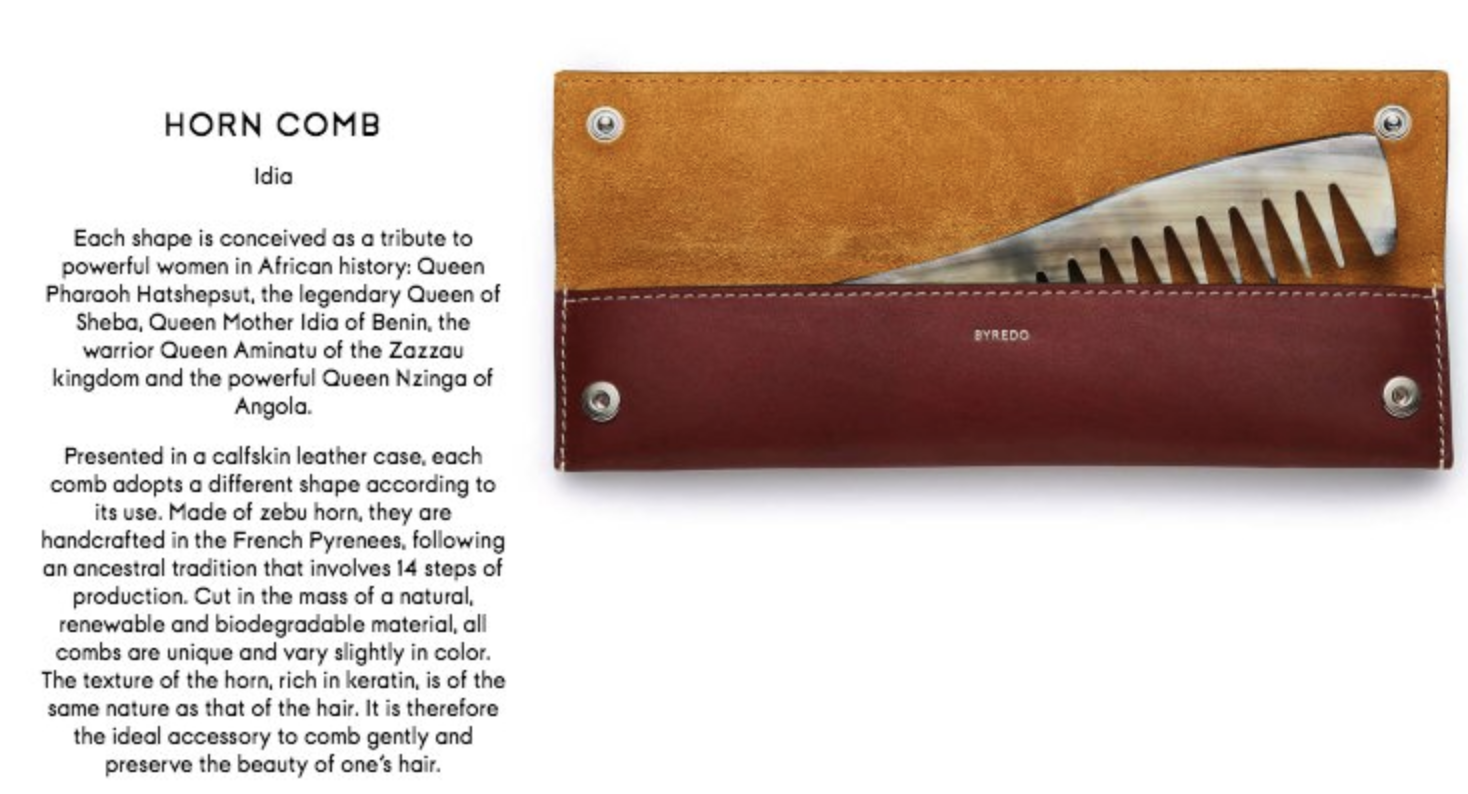
Product descriptions can live within a product page or a sales page. A product description is breezy and might live on a page with many other different products. The description helps add more clear and sometimes fun context to what the customer is looking at alongside the pictures, videos, and other details.
Writing a product description is still a form of copywriting, where it’s like unstacking a Russian doll: You want the customer to continually uncover small delights and surprises until they get to the core and they’re left wanting more…
Which gradually gets to…

We’ll go over a few important elements that you should focus and improve on when writing product descriptions:
How to write product descriptions that make you stand out
1. Know how your customers think and talk
I’m assuming that your product was built around a specific kind of customer, and my question to you is: How well do you know this person?
Because the key to writing a killer product description — heck, any effective copy — is to be BFFs with the customer’s hopes, fears, and pains, where you know their struggles and dreams better than even they themselves do. Before you write a single word. When we get into our customer’s mind, we create something we call a Customer Desire Map that looks like this:

The Customer Desire Map shows you where your customers are, where they want to be, and what’s in their way. Some tips on how to create your own Customer Mind Map:
- Talk to your customers: We spend on average three weeks talking to customers to learn how they talk, what’s on their mind, what they want, what they know about other products currently in the market, how they like their coffee or tea in the morning, and really anything else. Here is a GrowthLab article to get you started on this process.
- Write these from your customer’s perspective: Instead of telling what the customer should be feeling or thinking, you’re articulating their exact thoughts for them and making them think, “Wow, you’re reading my mind!” Example: “I hate when I sit down and feel my stomach spill over my pants. It’s so embarrassing and I wish I could just zap away my belly fat already!”
- Look for emotional intensity: The difference between someone saying “I guess that’s annoying…” and “I dread going to my closet every morning because I’m always overwhelmed by all the options of what to wear, so I end up throwing something together and I don’t truly feel my best” is a distinct level of emotional pain these statements tacitly convey. When you find that thread, tug on it hard.
All of this together helps you lay the foundation of what to say in your product description, so you never have to blank on what to write, and your description will be able to resonate much more deeply with customers.
2. Be clear and descriptive
Being clear and descriptive in a product description is “no duh” advice, but still I see something like:
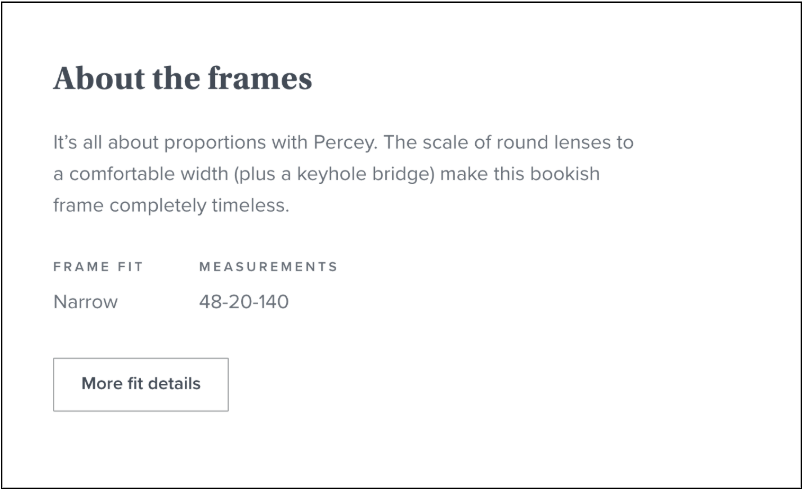
Umm, okay? I guess that sounds nice, but I’m not convinced I need this particular frame yet. I’m still waffling because these glasses are missing so much other information — oh, what’s that? I just need to scroll down...?

Arcane phrases like “custom cellulose acetate,” “Akulon-coated screws,” and “hand-polished for three days with a German wax compound” mean absolutely nothing to the average glasses shopper, aka me.
It’s like listening to a fitness know-it-all drone on about “overloading muscles with optimal mechanical tension, metabolic stress, and muscle damage” when all I really wanted to know was, “Will doing squats make my legs stronger?”
What Warby Parker could have said was something like: “Made from custom cellulose acetate, which makes our frames more durable for all those people who accidentally sit on their glasses at least once per week.” I would understand that (because that’s totally me)!
Features are important and nice to know for the people who want to dumpster-dive into the extra goodies, but people often buy based on how your product might help them be or align better with their self-image.
To only talk about how great your product is (in terms that few people understand no less) is to trample all over the most basic copywriting principle: emphasize benefits, not features.
Contrast Warby Parker’s product page with this example from Lululemon: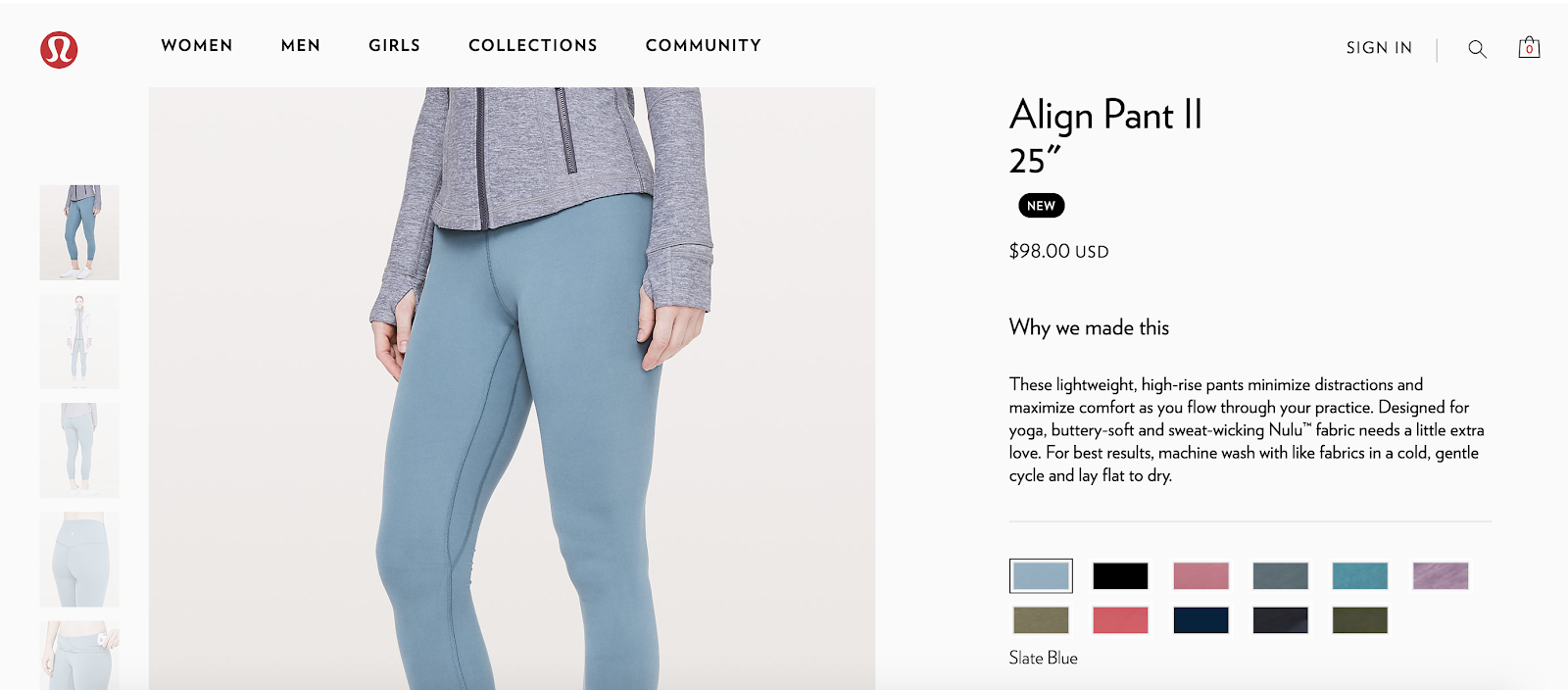
As a potential buyer, I’m getting more information on how it looks on a model and all the color and sizing options — great! Then there’s the cherry on top:
“These lightweight, high-rise pants minimize distractions and maximize comfort as you flow through your practice. Designed for yoga, buttery-soft and sweat-wicking Nulu™ fabric needs a little extra love. For best results, machine wash with like fabrics in a cold, gentle cycle and lay flat to dry.”
Assuming I were a yogi who kept getting frustrated that my pants would shift around too much or chafe me as I went through my yoga practice, descriptors like “lightweight” and “buttery-soft” line up exactly with how I want to feel when I practice yoga (be SUPER light and comfortable).
Such highly descriptive, sensory language beams certain images into my head so that I clearly understand. We call this “going from the clouds to the streets,” which is to say that you avoid airy-fairy, vague details and use concrete, in-your-face words that remove ambiguity.
The words you use might change depending on the demographic, age, and interests. Examples from The North Face:


If you’re selling a physical product with technical specs, you should definitely include them as an option for the buyer to view. For example, if I wanted to learn other details about the yoga pants, there is a drop-down available to me further down the page.

On the other hand, if you were selling an info-product, such as a course, the product description might look a little more like:

Notice that it still emphasizes the benefits for the reader, even though it’s talking about what the course entails.
3. Make the writing easy for your customers to understand
Oftentimes we forget something oh-so-very important: People are busy. If your description is hard to understand because you’re being unclear or are using big words, most people don’t have the time or patience to decipher exactly what you’re saying to them. That’s how you lose the sale!
To be clear and help make a connection, make your writing sound natural to your customers. Few ways to do this:
The “barstool test” checks how your words are stacking up in a casual, conversational setting.
Imagine that we’re sitting at a bar, the divey kind with a giant deer head mounted on the wall. If you’d said to me, “My mission is to optimize human understanding of their financial needs and goals in the 21st century,” I’d continue sipping my beer in silence.
However, if you’d simply said “I want to help you make and have more money,” I’d buy you a beer — no, three rounds of it — as you tell me more (but you’re leaving the tip, moneybags).
Our CEO on how GOOD copywriting has been critical to the growth of our business.
Additionally, many industries and circles have a unique lexicon. If you’re selling to niche industries with certain jargon, buzzwords, and sayings, you can use those “in” words to your advantage to become “one of them.” Examples:
- Writing: “Proven ways to write and pitch your manuscript to make literary agents want to work with you.”
- Rock climbing: “What project are you working on now? I just flashed the last one.”
- Weightlifting: “I try to time eating ample carbs around the time I aim for one-rep max on my deadlifts.”
This is part of knowing who exactly your customer is and how they typically talk or want to be spoken to, and still weaving your own brand and voice into the writing (some examples of this later in the article).
The world wants you to be vanilla...
…but you don’t have to take the same path as everyone else. How would it look if you designed a Rich Life on your own terms? Take our quiz and find out:
4. Use one of these five story archetypes
Remember the comb from earlier? Well, here it is again. I loved it because it didn’t just tell me about the product. It told me a story as the product description.
That comb though…
Here’s another example.

Some of the best copy is written as a story that hooks the reader in and carries them through every peak and trough of emotions. You can do this too for your product description by using one of these five tried-and-true story archetypes:
1. Paint the dream
One of the best ways to help your reader fully realize the benefits of your product is to help them paint a poignant picture of what their life would be like after they’ve used your product. To pull this off well, you need to zero in on evocative words and imagery so that you appeal directly to their imagination. Example:

2. Twist the knife
Your customer has come to your product with a specific problem and pain point in mind. Your goal with “twist the knife” is to emphasize that pain and dig in deeper. This is not to say you get all doom and gloom or be manipulative.
Instead you simply want to show that you deeply understand their pain — that you’ve been there and that things don’t have to continue being that way. I like this example from Online Trainer Academy:
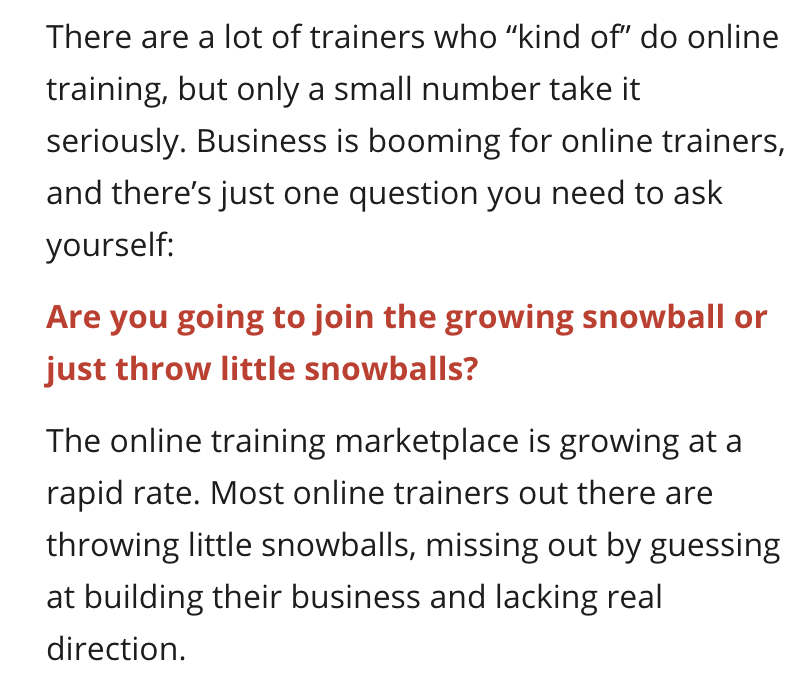
3. The great discovery
Batman had an origin story. So did Superman. And they become humanized.
The point is, we all love a good origin story. “The great discovery” is simply your product’s story of how it came to be, usually told through the lens of your own struggles that the reader can empathize with.
It’s effective because it feels authentic, like something the reader can relate to, and can share a powerful message about your product and how it can benefit others. Here’s an example from BestSelf’s course:
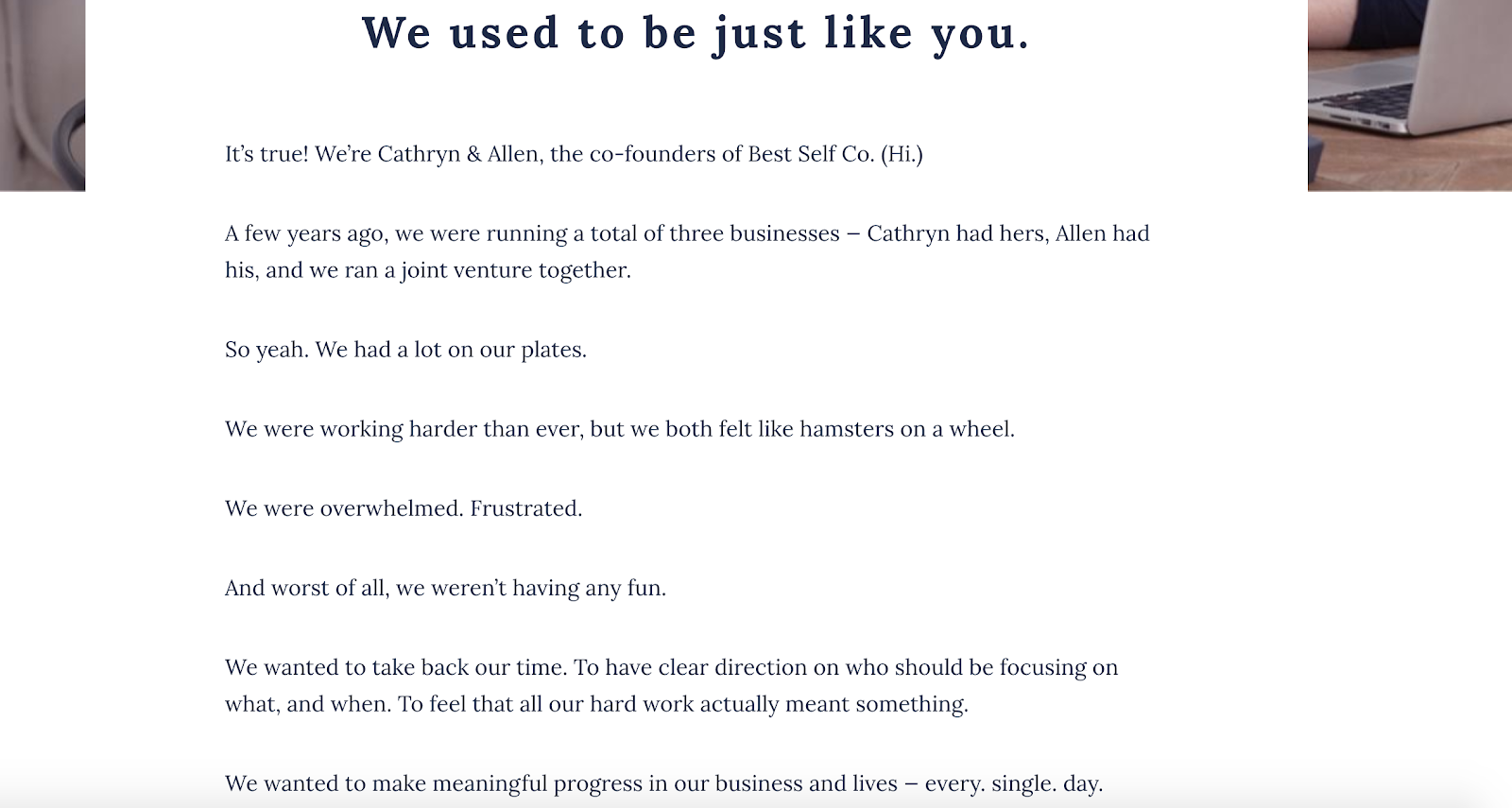
4. The unspoken truth
This is your opportunity to “come clean” because the assumption is that no one else is willing to say the things you’re about to. People like it when you cut the B.S. and get real with them.
If you believe an “industry secret” is worth being exposed, the unspoken truth can be a very powerful way to spark intrigue and trust. Here is JCD Fitness’s product for women:

5. The incredible story
Who doesn’t want to hear an incredible story? An incredible story doesn’t have to be over the top. The trick here is to get people salivating when they haven’t even gotten the food yet.

6 more examples of product descriptions that sell
We went over solid principles of how to write product descriptions, but what you’ll come up with will depend on your brand, product, and who your customers are. Length and level of detail aren’t hard-and-fast rules. In fact, many brands kick traditional guidelines to the curb and still do awesome stuff.
Here are six examples of different products and brands to show just how wide and varied great examples of product descriptions can be.
1. This journal
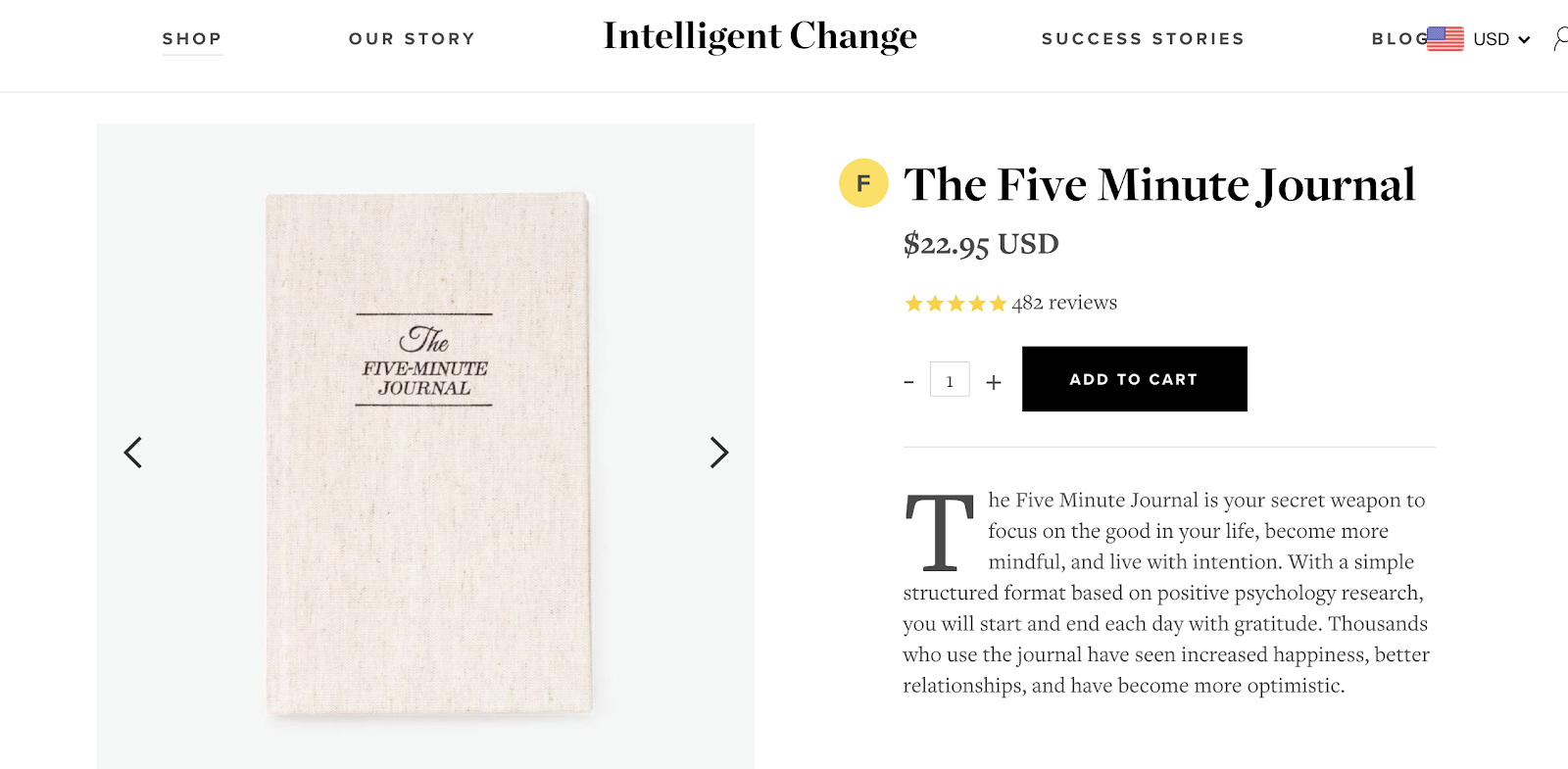
This journal from Intelligent Change really knows their getting-in-touch-with-our-inner-peace, high-performing entrepreneur-like crowd, as the copy relentlessly drives home the point that using this journal will help you be a better, grounded human amid the chaos of life. (I have one.)
2. This stylish commuter backpack
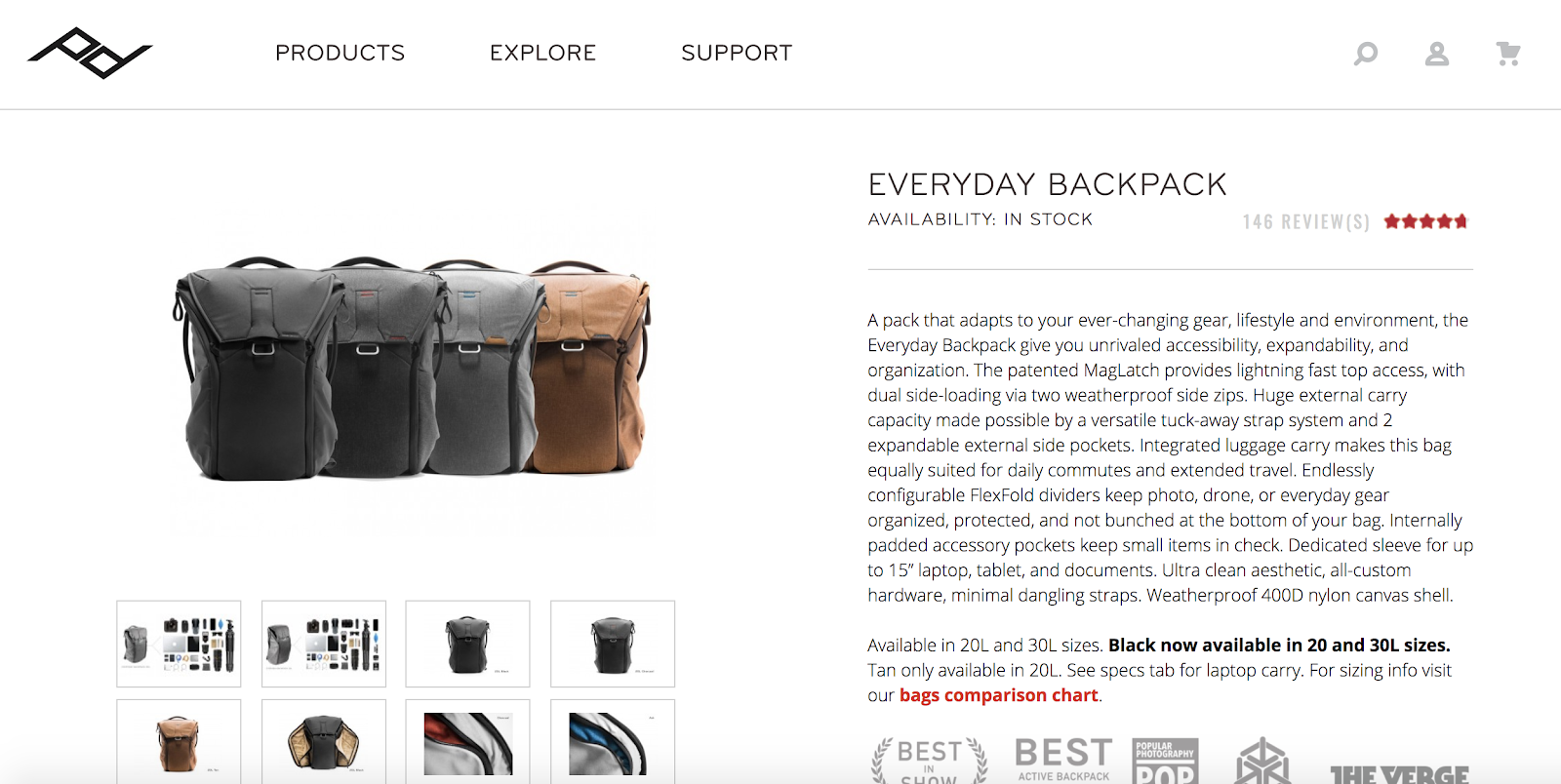
I totally own this backpack from Peak Design, and while the brand itself was recommended to me, I bought after looking through the product page and watching the videos.
It provided me with enough high-quality pictures, and as a “digital nomad,” I loved that the bag was versatile enough to adapt to “ever-changing gear, lifestyle, and environments.” It was as if it was made for me.
3. This fitness supplement guide
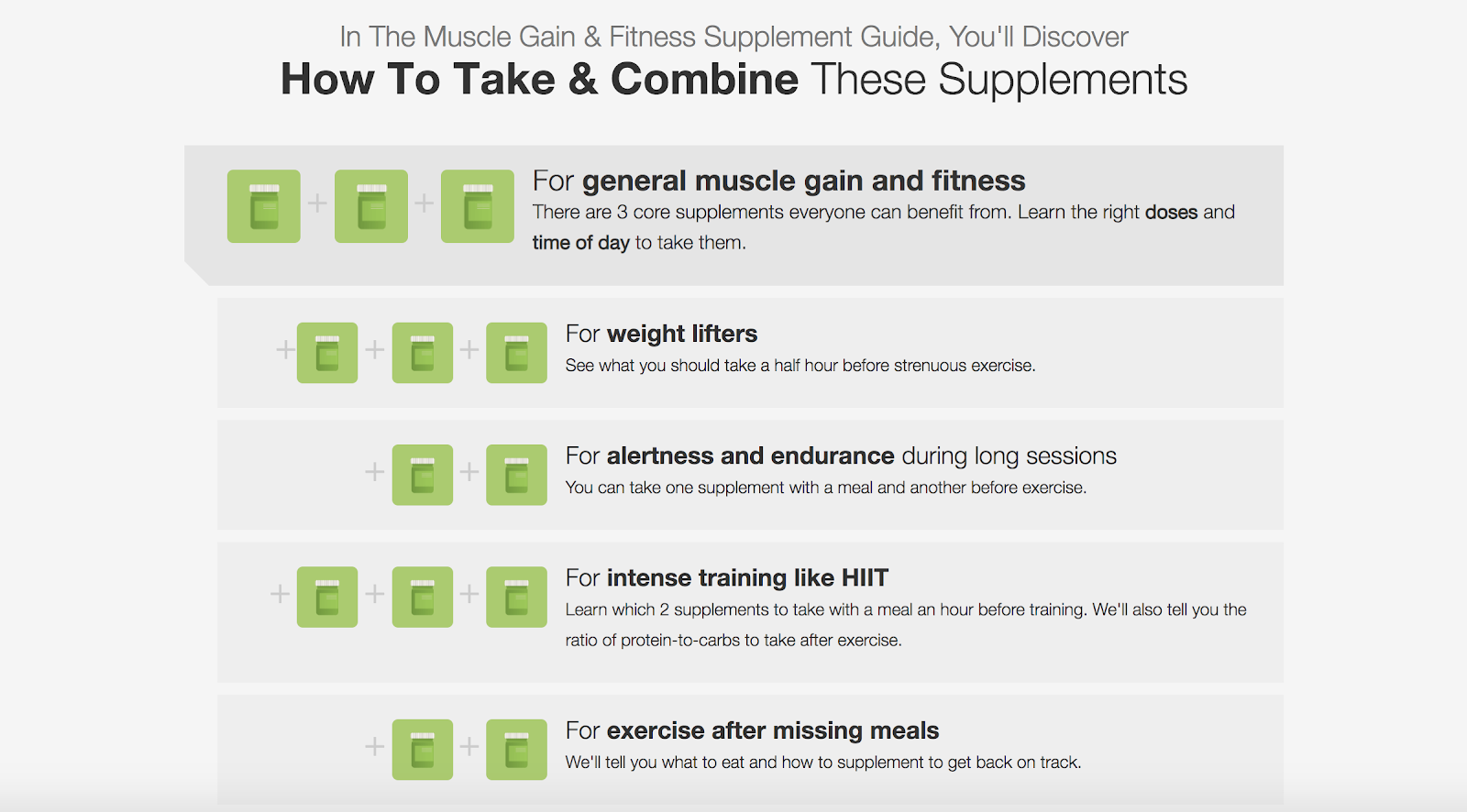
From the folks at Examine.com, an independent resource for nutrition information, this product description from their supplement guide is easy on the eyes and quickly tells you what you will learn (the features) and how that’ll help you (benefits). It’s the perfect illustration of presenting benefits as features.
4. These yellow shoes

Modcloth writes quirky, unexpected product descriptions that tell a story. I have fun reading the descriptions and they help me imagine what it’s like (“you’ll recall fond moments while forming new, unforgettable ones”) to own them.
If you’ve read this far, you’d LOVE our Ultimate Guide to Remarkable Content
It’s one of the best things we've published, and totally free – just tell us where to send it:
5. This collection of scripts
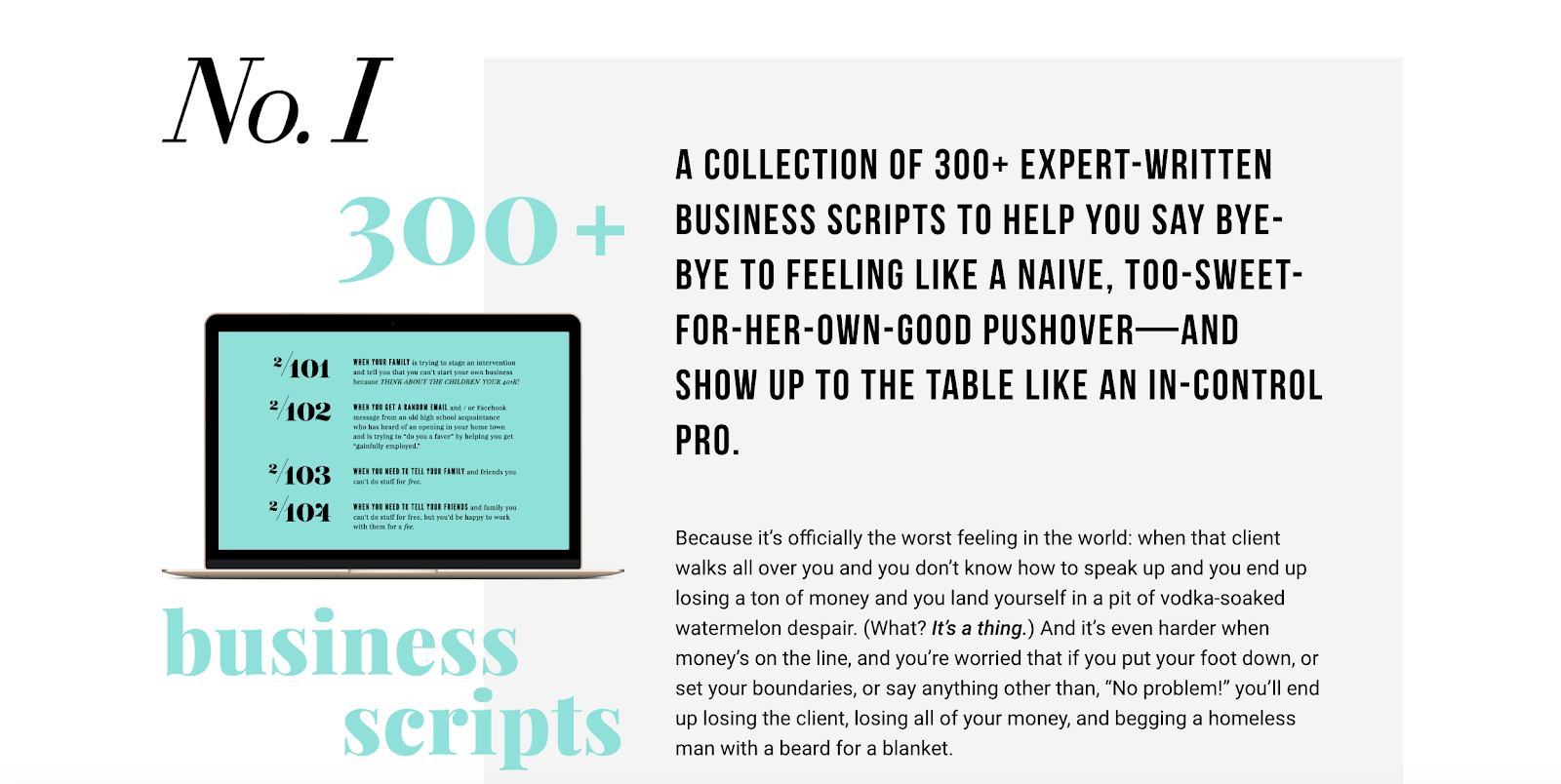
From The Middle Finger Project, this product — a mere collection of business scripts — is so enticing for a consultant or solopreneur wanting to build a sustainable business.
They can relate to this copy of when a client “walks all over you and you don’t know how to speak up and you end up losing a ton of money…” It’s a struggle so embarrassing to admit, and nobody wants to feel that way!
6. This meal replacement shake

Right next to the “Buy now” button on Beachbody was an option to “View details,” which took me to the screenshot above. Notice that it emphasizes all the benefits of using the product, using simple, insider language (e.g., “build lean muscle” and “fight free radical damage”) that speaks to the wants of this particular customer.
Want to learn how to write copy that people will BUY?
It took us a long time to learn this, but nobody wants to JUST buy a new bed.
What they want is a good night's sleep.
You may have heard about features and benefits before, but few people truly understand how to differentiate between the two — and what doing so can mean for your revenue. Let us show you some examples of features versus benefits:
Features
- A 3-month fitness program
- 5 of my favorite 30-minute weight loss recipes
- Storage for 1 gigabyte of MP3s
Benefits
- You can look amazing — in just 3 months!
- No more slaving away in the kitchen for hours
- 1,000 songs — all in your pocket
Simply put: Features bore people. Benefits excite people.
But how do you actually uncover the benefits that sell your product?
In the special report below, you’ll learn how to turn any product features into super-compelling benefits. This way, you get people to buy from you over everyone else.
We’ve used these tactics to launch 18+ successful products and consistently grow our business year after year.

Let us show you how you can do the same with your products inside this special report.
You'll also learn:
- What benefits actually drive people to buy. Hint: Not all product benefits work the same
- How to answer the “What’s in it for me?” question so your customers buy without hesitation
If you liked this post, you’d LOVE Ramit's New York Times Bestselling book
You can read the first chapter for free – just tell us where to send it: